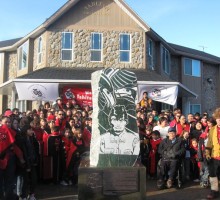People
The Tahltan people have occupied their territories around the upper reaches of the Stikine River in what is now northwestern British Columbia since time immemorial. The relationship between the people and the land, as with many indigenous peoples, is one marked by a deep respect for the land as provider and a strongly held belief that the people are keepers of the land. The Tahltan belong to the land. This prevailing attitude has led to a symbiotic relationship in which the Tahltan people look to the land for sustenance, guidance, and healing. Traditional Tahltan governance was organized around the family/clan system. All decisions affecting Tahltans were made through meetings and councils, and every Tahltan was allowed to express their views and concerns.
Primarily a hunting and trapping people, the Tahltan fostered inter-tribal trade with neighbouring tribes exchanging items such as fish, furs and obsidian, useful for making tools and weapons. In fact, the Tahltan people held a significant position in as middlemen in the pre and post-contact trading industry of northern BC. The Stikine River supported trade that took place between coastal nations and interior nations. The first contact with Europeans came in 1838 when Robert Campbell of the Hudsons Bay Company arrived with intentions on setting up operations in the territory.
In the early 1900s, the population of the Tahltan Nation was devastated by smallpox, measles, influenza and tuberculosis; diseases introduced by European explorers to which the Tahltan people had no natural immunity. At its lowest point, the Tahltan population numbered under 300 people. This extreme population decrease, coupled with the new enforcement of governmental policies, forced the Tahltan people to leave their established villages sites for a more central location along the Stikine River. The discovery of gold in the Yukon supported the creation of a larger village site along the banks of the Stikine River. At the beginning of the 19th century the Tahltan Nation played host to over 5000 potential prospectors, as their village became an official stopping point on the river way towards the Yukon Klondike.
